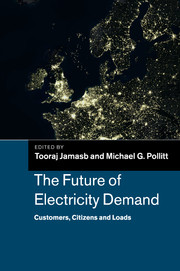Book contents
- Frontmatter
- Contents
- List of Figures
- List of Tables
- List of Boxes
- List of Contributors
- Foreword
- Preface
- Acknowledgements
- Introduction and overview of the chapters
- Part I The economics
- 1 The economics of energy (and electricity) demand
- 2 Energy scenarios and implications for future electricity demand
- 3 Demand-side participation: price constraints, technical limits and behavioural risks
- 4 Review of recent developments in economic modelling of energy demand
- Part II Technology
- Part III Social dimensions
- Part IV Policy and regulation
- Index
- References
1 - The economics of energy (and electricity) demand
from Part I - The economics
Published online by Cambridge University Press: 05 March 2014
- Frontmatter
- Contents
- List of Figures
- List of Tables
- List of Boxes
- List of Contributors
- Foreword
- Preface
- Acknowledgements
- Introduction and overview of the chapters
- Part I The economics
- 1 The economics of energy (and electricity) demand
- 2 Energy scenarios and implications for future electricity demand
- 3 Demand-side participation: price constraints, technical limits and behavioural risks
- 4 Review of recent developments in economic modelling of energy demand
- Part II Technology
- Part III Social dimensions
- Part IV Policy and regulation
- Index
- References
Summary
Introduction
In the UK, electricity demand grew by 2.4 per cent p.a. between 1970 and 2005, to reach a record high of 357 TWh, but then declined to 330 TWh in 2009 following the sharp recession which began in 2008. However, longer-run trends suggest increasing electricity demand globally in the future, and even in the UK. Figure 1.1 shows the trends in electricity consumption in the UK since 1960 for various sectors: residential, public administration, transport, agricultural and commercial sectors, and industrial. In the residential sector, consumption increased by 59 per cent between 1970 and 2009 (DUKES, 2010). The largest household electricity consumption increase is due to consumer electronics, as will be shown later in this chapter. Commercial and public services have used sharply more electricity since 1970, with a rise of 140 per cent to 2009 (DUKES, 2010). Consumption by industry, by contrast, has been decreasing recently, with a steady fall since 2005, partly due to deindustrialization, the recent recession and increased energy efficiency (DECC, 2010a). In the longer run, however, electric vehicles and the electrification of the heat sector (should natural gas decline as the heating fuel of choice) will provide significant new sources of growth in electricity demand.
Figure 1.2 shows the scale of the potential impact of electrification of transport and heat on household electricity demand. Household transport demand for petroleum is around four times the energy value of the electricity used for lighting and appliances. Electrification of water and space heating, currently largely (though not entirely) supplied via natural gas, would produce a significant rise in demand for electricity.
- Type
- Chapter
- Information
- The Future of Electricity DemandCustomers, Citizens and Loads, pp. 17 - 47Publisher: Cambridge University PressPrint publication year: 2011
References
- 9
- Cited by



